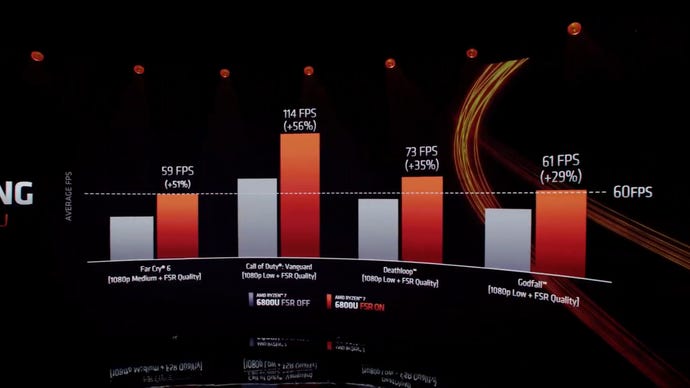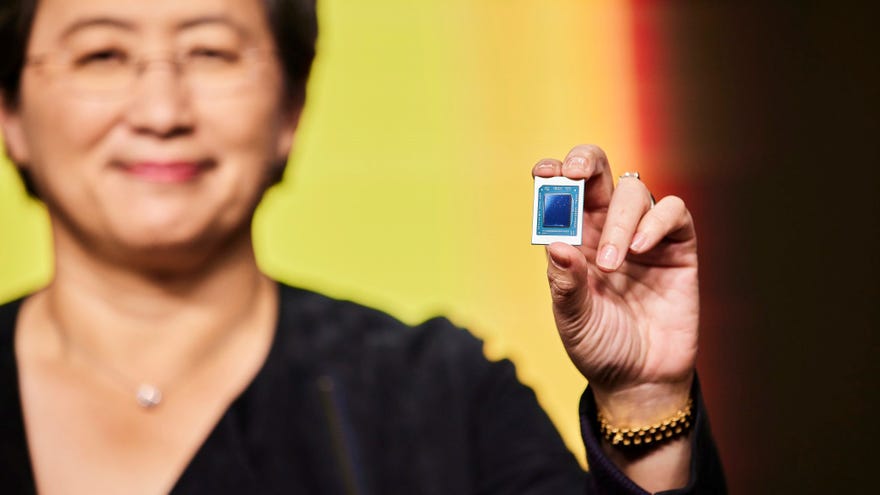CES 2022: AMD confirms Ryzen 7000 CPUs, Radeon RX 6500 XT graphics card and more
Including possibly the first integrated graphics that aren’t hopeless
It’s the first week of 2022 and that means – yes! – all the big PC hardware movers and shakers are hosting their CES 2022 events. On the same day. Within a couple of hours of each other. But my stress is your gain, as there are and will be some major announcements on new kit, starting with AMD. Their freshly-announced hardware includes an assortment of new CPUs, desktop and mobile graphics cards and even some laptop APUs – APUs that sound a lot more useful for gaming that what current integrated graphics can offer. There’s even an Nvidia Image Scaling rival in the upcoming, driver-level Radeon Super Resolution feature.
Let’s start with how the show ended, namely with the AMD Ryzen 7000 series of desktop CPUs. No specs, pricing or benchmarks were shown, sadly, but CEO Dr Lisa Su did at least confirm that the Zen 4-powered chips are on track to launch in the second half of 2022. That’s hopefully reassuring news to anyone worried about pandemic-inflicted production problems causing delays, though note that you won’t be able to simply add these chips to your existing motherboard. Yup, Ryzen 7000 will also introduce a new socket, AM5. That’s the first replacement socket since Ryzen first launched, with the AM4 socket, back in 2017.

The other big reveal was the Radeon RX 6500 XT, a long-overdue budget GPU based on the RDNA 2 architecture. As such, this $199 graphics card will support familiar features like ray tracing and FidelityFX Super Resolution (FSR) when its partner models start launching on January 19th. Will it be immediately consumed by resellers and cryptocurrency miners? Almost definitely, but hey, not even Nvidia has attempted to make a true low-end GPU in ages. The RX 6500 XT also has an intriguingly high ‘game clock’ speed of 2.6GHz, and while that’s only alongside 4GB of GDDR6, AMD claim it can hit up to 78fps at 1080p/High in Halo Infinite and up to 108fps in Resident Evil Village.
On the laptop side of GPUs, AMD also announced a trio of ultraportable-spec mobile graphics processors in the Radeon RX 6800S, RX 6700S and RX 6600S, while the existing RX 6000M series is getting a new flagship model in the RX 6850M. The latter could become a mainstay of high-end laptops, given it’s sort-of replacing the RX 6800M, though the 6000S series sounds interesting too. Both the RX 6800S and RX 6700S are supposedly capable of 100fps-plus frame rates when playing games at 1080p with max settings; which games exactly, however, weren’t listed.
AMD’s new APUs could be another alternative for those who prefer lightweight laptops to conventional gaming bricks. You won’t get performance on par with even the RX 6600S, but the Ryzen 7 6800U (a mid-to-high-ranger among the 20 new APUs) was shown to manage a 59fps average in Far Cry 6, using a combination of 1080p, Medium quality settings and an FSR boost. Even the relatively taxing Deathloop can apparently average 75fps with FSR, albeit sticking to 1080p and Low quality.

Speaking of FSR, Radeon Image Scaling (RSR) was announced to join AMD’s Adrenalin software suite. Like Nvidia Image Scaling, it aims to bring the performance benefits of upscaling to games that don’t natively support a dedicated system like FSR or DLSS. RSR simply applies an upscaling algorithm to whatever you’re playing, boosting performance by effectively letting your PC run it a lower resolution before it’s upscaled to native resolution.
Although you probably shouldn’t expect comparable quality to dedicated FSR upscaling (and definitely not to DLSS, which also includes its own AI-aided anti-aliasing)….who knows, it might be useful if you’re having serious trouble running an FSR-less game at an adequate performance level. And if you have an AMD GPU, the list of which just got longer.


